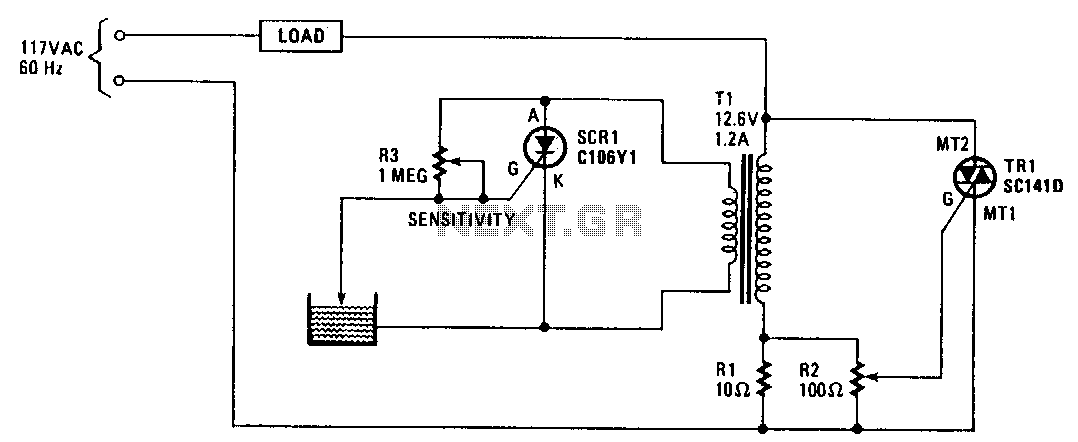
Water-level-sensor-and-control

When the water level is low, the probe is out of the water, causing SCR1 to be triggered. This results in the SCR conducting and imposing a significant load on the secondary winding of transformer T1. This load is reflected back into the primary winding, which activates triac TR1, energizing the load. If this load is an electric valve in the water supply line, the valve will open and remain open until the water level rises and touches the probe. This contact shorts the gate and cathode of SCR1, turning it off and effectively open-circuiting the secondary. The resulting open-circuit condition, when reflected back to the primary winding, removes the trigger signal from the triac, thereby stopping the water flow.
The described circuit functions as a water level control system, utilizing a probe, SCR, transformer, and triac to manage water supply effectively. The probe serves as a sensing element that detects the water level. When the water level falls below a predetermined threshold, the probe becomes exposed, triggering SCR1. The conduction of SCR1 creates a load on the secondary winding of transformer T1, which induces a corresponding voltage in the primary winding. This induced voltage activates triac TR1, allowing current to flow to the load, which in this scenario is an electric valve.
The electric valve opens to allow water to flow into the supply line. This operation continues until the water level rises sufficiently to make contact with the probe again. At this point, the probe shorts the gate and cathode of SCR1, effectively turning it off. This action leads to an open circuit condition in the secondary winding of the transformer, which is reflected back to the primary winding. The absence of the load signal on the primary winding results in the removal of the trigger signal to triac TR1, thus deactivating the valve and stopping the water flow.
This circuit is an efficient and reliable method for controlling water levels in various applications, ensuring that water is supplied only when necessary and preventing overflow or wastage. The use of solid-state components like SCRs and triacs enhances the durability and responsiveness of the system, making it suitable for both residential and industrial applications. Proper component selection and circuit design are crucial for optimal performance and reliability in real-world conditions.When the water level is low, the probe is out of the water and SCRl is triggered on. It conducts and imposes a heavy load on transformer Tl"s secondary winding. That load is reflected back into the primary, gating triac TRl on, which energizes the load. If the load is an electric valve in the water-supply line, it will open and remain open until the water rises and touches the probe; this shorts SCRl"s gate and cathode, thereby turning off the SCRl, which effectively open-circuits the secondary. That open-circuit condition, when reflected back to the primary winding, removes the triac"s trigger signal, thereby turning the water off. 🔗 External reference
The described circuit functions as a water level control system, utilizing a probe, SCR, transformer, and triac to manage water supply effectively. The probe serves as a sensing element that detects the water level. When the water level falls below a predetermined threshold, the probe becomes exposed, triggering SCR1. The conduction of SCR1 creates a load on the secondary winding of transformer T1, which induces a corresponding voltage in the primary winding. This induced voltage activates triac TR1, allowing current to flow to the load, which in this scenario is an electric valve.
The electric valve opens to allow water to flow into the supply line. This operation continues until the water level rises sufficiently to make contact with the probe again. At this point, the probe shorts the gate and cathode of SCR1, effectively turning it off. This action leads to an open circuit condition in the secondary winding of the transformer, which is reflected back to the primary winding. The absence of the load signal on the primary winding results in the removal of the trigger signal to triac TR1, thus deactivating the valve and stopping the water flow.
This circuit is an efficient and reliable method for controlling water levels in various applications, ensuring that water is supplied only when necessary and preventing overflow or wastage. The use of solid-state components like SCRs and triacs enhances the durability and responsiveness of the system, making it suitable for both residential and industrial applications. Proper component selection and circuit design are crucial for optimal performance and reliability in real-world conditions.When the water level is low, the probe is out of the water and SCRl is triggered on. It conducts and imposes a heavy load on transformer Tl"s secondary winding. That load is reflected back into the primary, gating triac TRl on, which energizes the load. If the load is an electric valve in the water-supply line, it will open and remain open until the water rises and touches the probe; this shorts SCRl"s gate and cathode, thereby turning off the SCRl, which effectively open-circuits the secondary. That open-circuit condition, when reflected back to the primary winding, removes the triac"s trigger signal, thereby turning the water off. 🔗 External reference
Warning: include(partials/cookie-banner.php): Failed to open stream: Permission denied in /var/www/html/nextgr/view-circuit.php on line 713
Warning: include(): Failed opening 'partials/cookie-banner.php' for inclusion (include_path='.:/usr/share/php') in /var/www/html/nextgr/view-circuit.php on line 713